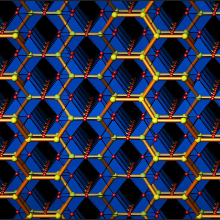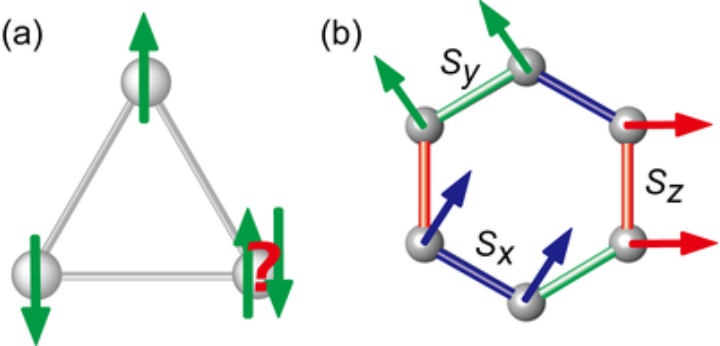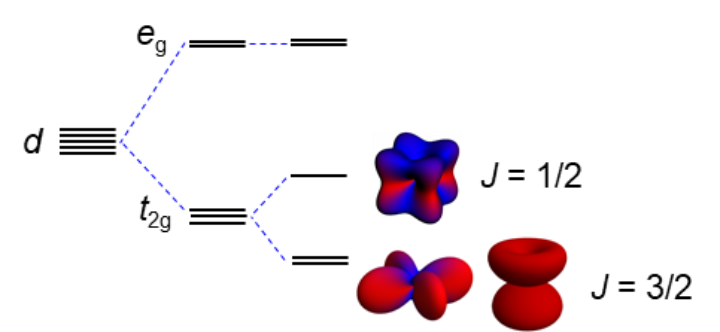Novel Quantum Materials
Our research interest lies in development of novel quantum materials, particularly in transition-metal compounds. In quantum materials, entanglement of electrons takes place primarily due to Coulomb repulsion, which leads to a variety of “phases” of electrons such as solid, liquid, gaseous states. In the entangled (correlated) states, the multiple electron degrees of freedom – charge, spin and orbitals- manifest themselves explicitly and, in combination with unique lattice topology, produce novel electronic states exemplified by high-Tc superconductivity, multiferroicity and various spin-orbital ordering phenomena. Such electronic states are not only fundamentally interesting but sometimes exploited as novel functionalities.
We are exploring new quantum materials, aiming for novel electronic states such as unconventional superconductivity, exotic magnetism, non-trivial topological state of matter and novel functionalities. Discovery of new materials displaying such exotic electronic state is most fundamental subject but a quite important seed for the research of condensed matter physics.
Research topics
The realization of quantum spin liquid, which was originally proposed by P. W. Anderson in 1973 [1], has been a long-standing challenge in condensed matter physics. When antiferromagnetically interacting spins are placed on a lattice of triangular motif, the spins cannot satisfy all magnetic coupling simultaneously (dubbed magnetic frustration), and macroscopic degeneracy remains in the ground state. Combined with quantum fluctuation, high-entangled liquid state of spins, called quantum spin liquid, is expected to emerge. Quantum spin liquid is distinct from a simple spin disordered state, but hosts non-local topological order with exotic fractionalized excitations. Despite the tantalizing physics of quantum spin liquid, there are only a handful of candidate materials to date. In most of frustrated magnets, magnetic frustration is relieved by distorting the underlying lattice or disorder present in a crystal drives the system to a glassy frozen state.
There is another possible route for quantum spin liquid which was proposed by A. Kitaev [2]. Kitaev proposed an S = 1/2 honeycomb model with bond-dependent Ising coupling. This model is shown to be exactly solvable, and the ground state is a gapless or gapped spin liquid depending on the anisotropy of coupling strength. The Kitaev honeycomb model has been regarded as a toy model for theoretical studies since implementing the bond-dependent Ising coupling in a solid is quite difficult. Recently, it was proposed that such magnetic coupling can be realized in heavy transition-metal oxides such as 5d iridium oxides [3]. Several candidate materials for Kitaev spin liquid were put forward but no true spin liquid ground state has been seen yet. We are exploring new candidates for Kitaev spin liquid by utilizing various chemical techniques.
[1] P. W. Anderson, Mat. Res. Bull. 8, 153 (1973).
[2] A. Kitaev, Ann. Phys. 321, 2 (2006).
[3] G. Jackeli and G. Khaliullin, Phys. Rev. Lett. 102, 017205 (2009).
We are searching for new superconductors exhibiting high transition temperature and/or unconventional pairing origin. Exotic superconductivity often emerges at a critical point of competing electronic order as exemplified by high-Tc cuprates, iron pnictides and heavy fermion systems. So far we have discovered superconductivity at a critical point of spin-orbital order in ruthenium phosphide (RuP) [1]. Currently, we are searching for superconductivity by suppressing competing order with the aid of high-pressure up to 10 GPa.
In addition, superconductivity under the influence of strong spin-orbit coupling is of particular interest. For example, non-centrosymmetric superconductors with strong spin-orbit coupling are discussed to display unconventional pairing. We are exploring new superconductors including 4d and 5d transition-metal elements. Up to now, we have found several 5d-based superconductors such as strong-coupling superconductor SrPt3P [2] and quasi-1D system Ta2PdxS5 with large upper critical field violating Pauli limit [3].
[1] D. Hirai et al., Phys. Rev. B 85, 140509 (2012).
[2] T. Takayama et al., Phys. Rev. Lett. 108, 237001 (2012).
[3] Y. F. Lu et al., J. Phys. Soc. Jpn. 83, 23702 (2014).
Under the strong spin-orbit coupling, the electronic state of a magnetic ion is well described by the total angular momentum J rather than the orbital angular momentum L or spin angular momentum S. The “J state” has peculiar charge and spin distribution as shown in the figure below.
When the spin-orbital entangled electrons are arranged in crystal lattices, new-type of magnetic interactions are expected to occur between them, which may lead to the realization of novel quantum ground states. For example, non-collinear magnetic orders and quadrupolar orders in J = 3/2 magnets on face-centered-cubic (FCC) lattice and spin liquid states in J = 1/2 magnet on honeycomb lattice are theoretically proposed.
Recent experiments have revealed that such “J states” are actually realized in the 5d transition metal compounds. For example, J = 3/2 and 1/2 electrons take physical properties in Re6+ (5d1) and in Ir4+ (5d5) systems, respectively. We synthesize new compounds in which 5d ions with various electron counts are arranged in different types of lattices such as FCC, honeycomb, square, triangular, and pyrochlore lattices and investigate their magnetic properties to discover novel quantum ground states and to understand the mechanisms of the magnetism.
Correlated electron systems, such as transition metal oxides, offer a variety of exotic electronic phases due to the interplay between charge, orbital and spin degrees of freedom of localised d electrons. This interplay becomes especially subtle in frustrated systems, where competing interactions cannot be satisfied simultaneously. Mott insulators with partially filled orbitals are particularly interesting due to degeneracy of spatially anisotropic orbitals, which is sensitive to the lattice symmetry. In such systems, the character of magnetic exchange, magnetic ordering and the type of superstructure are determined via selection of an orbital (or linear combination of orbitals), usually accompanied by a structural and electronic transition. This commonly results in long-range orbital and magnetic order, for example in perovskite LaMnO3 or frustrated spinel MgV2O4. In some cases, such orbitally degenerate correlated electron systems do not fall into a conventional long-range magnetic order, but instead select an entangled spin singlet state, which is particularly interesting because it is a manifestation of the quantum character of d electrons. The superstructures containing spin singlet dimers or clusters depend on the d electron count, orbital occupation and the geometry of the lattice, where the phenomenon can be understood by different mechanisms in individual cases. In spinels CuIr2S4 and MgTi2O4 it is proposed that reduction of dimensionality caused by orbital ordering drives the system into a Peierls transition, rendering octamers [1] and a helical structure [2], respectively. On the other hand, in pyrochlore Tl2Ru2O7 structural transition and orbital ordering give a first example of 1D zigzag Haldane chain in a 3D system [3]. In our work, we explore new materials displaying novel spin-orbital order with spin singlet formation and study excitations of such ordered states. We are especially interested in 4d and 5d systems, where spin-orbit coupling enters the competition between interactions and potentially destroys spin-orbital order and spin-singlet state [4].
[1] P. G. Radaelli et al., Nature (London) 416, 155 (2002)
[2] M. Schmidt et al., Phys. Rev. Lett. 92, 056402 (2004)
[3] S. Lee et al., Nature Materials 5, 471-476 (2006)
[4] T. Takayama et al., Scientific Reports 4: 6818 (2014)
Example of thesis projects
We explore novel superconductors at a critical point of competing electronic orders. For the purpose, we employ a homemade pressure cell available up to 10 GPa. Particular interest is in magnetic materials which lack space inversion symmetry. Unconventional Cooper pairing can be expected in such systems once magnetic order is suppressed.
When a transition-metal ion in an octahedral coordination has 4 d-electrons in t2g manifold, strong spin-orbit coupling leads to J = 0 local ground state which is non-magnetic. Such J = 0 state may interact with each other via excited J = 1 state [1]. If the energy gain by the exchange interaction overcomes the J = 0 to 1 excitation, which is of the order of spin-orbit coupling, the system eventually undergoes a magnetic order. Therefore, for such d4 system, spin-orbit coupling and magnetic exchange compete and exotic magnetic ground state like spin liquid is expected at a critical point of two energy scales. We explore materials hosting such exotic magnetism, especially in complex ruthenium (Ru4+) oxides.
[1] G. Khaliullin, Phys. Rev. Lett. 111, 197201 (2013).
The possible realization of Kitaev spin liquid in iridates has been attracting tremendous attentions recently. We have discovered some candidates for Kitaev spin liquid such as b-Li2IrO3 under pressure and ion-exchanged a-Li2IrO3. We plan to investigate the detailed properties of spin liquid state by perturbing the honeycomb(hyperhoneycomb) lattice of Ir4+ with other ions.
Besides iridates, heavy transition-metal compounds potentially exhibit a plethora of exotic magnetism originating from spin-orbital entangled state. One of the interesting systems is d1 or d2 FCC lattice where unconventional multipole order is expected.
In a perovskite iridate SrIrO3, the interplay between spin-orbit coupling and its crystalline symmetry is discussed to give rise to Dirac dispersion in the electronic structure [1]. In contrast to other Dirac semimetals, the Dirac semimetallc state in SrIrO3 appears in the vicinity to correlated Mott insulating state like Sr2IrO4, and thus may offer an interesting playground to study the correlated topological physics. We aim at synthesizing new perovskite iridates harboring such Dirac dispersion and also exploring magnetic and non-centrosymmetric analogues by employing high-pressure synthesis technique.
[1] M. A. Zeb and H. Y. Kee, Phys. Rev. B 86, 085149 (2012)
A stable form of solid is determined by ionic radius of constitute elements, preferred coordination and valence state and so on. In addition to these, at high temperature configurational entropy may dominate the phase stability. Such entropy-stabilized materials like alloys may benefit in some applications due to, for example, their special mechanical properties. Recently, such entropy-stabilized phases have been demonstrated in simple rock-salt oxides with the mixture of several transition-metals [1], and they were found to exhibit unique electronic properties which are not seen in each constitute oxide [2]. We attempt to develop such entropy-stabilized oxides with interesting lattice network such as 2D triangular lattice, and explore exotic electronic properties.
[1] C. M. Rost et al., Nature Com. 6, 8485 (2015).
[2] D. Berardan et al., Phys. Status Solidi RRL 10, 328 (2016).
Facilities
About our equipment for materials synthesis and measurements, please refer to here.





